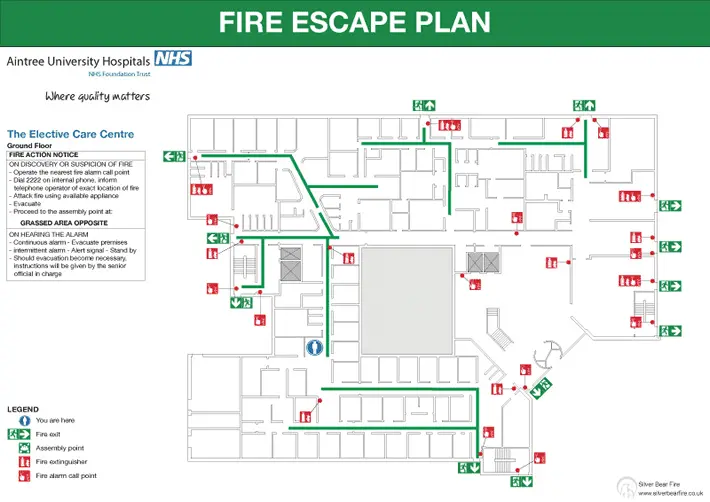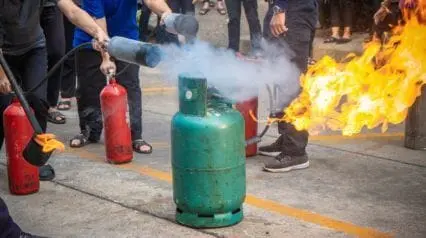What is a Fire Safety Plan?
A fire safety plan is an official document guiding the organization on procedures in the event of a fire incident. It is an Occupational Safety and Health Administration (OSHA) regulation, ordering employers to develop and implement an arrangement that will cover all actions they must take to ensure the safety of employees. A fire safety plan highlights crucial emergency procedures such as regular fire safety checks, fire safety training, fire department notification, and evacuation plan. Being unable to prepare a fire safety plan can lead to business lawsuits, property damage, employee accidents, or fatality.
Importance of a Fire Safety Plan
Having a fire safety plan prepares the organization in preventing injuries, costly damages, and potential fines in an occurrence of a fire incident. It is designed to ensure the following:
- identify critical equipment that needs to be shut off;
- define the information on how to provide emergency services;
- procedure to follow on sounding emergency alarms;
- provide support for persons with disabilities; and
- communicate evacuation plans including procedures and exit routes.
What Should be Included in a Fire Safety Plan?
The responsibility of employers is to ensure the safety of their employees. It is vital to communicate and review fire safety plans within 90 days for current employees and upon employment for new hires. It is recommended to update the plan when necessary, or at least annually. According to OSHA regulations, a fire prevention plan should at least include:
- A list of all major fire hazards, proper handling and storage procedures for hazardous materials (HAZMAT) and pyrophoric materials, potential ignition sources and their control, and the type of fire protection equipment necessary to control each major hazard;
- Procedures to control accumulations of flammable and combustible waste materials;
- Procedures for regular maintenance of safeguards installed on heat-producing equipment to prevent the accidental ignition of combustible materials;
- Procedures for notifying employees and fire response organizations;
- The name or job title of employees responsible for maintaining equipment to prevent or control sources of ignition or fires;
- The name or job title of employees responsible for the control of fuel source hazards; and
- Procedures to account for all employees after an evacuation.
Improve your EHS Management
Cultivate a safe working environment and streamline compliance with our EHS solutions.
Explore now3 Most Important Elements of an Effective Fire Safety Plan
An effective fire safety plan is the sum of its parts, and it is important to understand each of those parts to ensure they are well-integrated into the plan. Each element contributes to minimizing fire risks and helping fire safety officers develop fire safety inspection procedures and strategies. There are three key elements of a fire safety plan including the following:
Fire Prevention
The best fire fighting measure is prevention. It is important that workers are trained on fire safety in order for them to develop heightened awareness about fire hazards. They should be knowledgeable about emergency procedures and the operation of fire protection equipment. Fire risk assessments are also necessary as they provide insight on which hazards are present and the necessary measures to manage their risk. Safety officers can utilize fire safety checklists to conduct comprehensive checks of these aspects of the fire safety plan.
Fire Fighting
Fire safety plans should include regular inspections of equipment for active fire protection (AFP), such as fire alarms, fire extinguishers, fire sprinkler systems, and smoke detectors, to ensure they are functional at all times. Safety officers and facility engineering teams must carefully plan and design the appropriate fire fighting and protection system as this is the first thing the people will rely on in case of an incipient fire.
Emergency Evacuation
Although individuals can fight incipient fires with fire fighting equipment, the management should still put importance on how to safely evacuate the people during a fire emergency. Everyone should know the emergency evacuation plan, which includes contact details of safety authorities, emergency exit map, and other fire emergency protocols. To measure knowledge of emergency evacuation plans, fire safety plans should also include regular fire drills to ensure readiness.

Fire Safety Plan Example | Source: https://www.firesafe.org.uk/
How to Create a Fire Safety Plan
In a split second, a fire can be huge enough to put everyone in danger. It is crucial for every organization to prepare and create a fire safety plan to ensure safety not just for their employees but for the business as well. The following guidelines can help create an effective fire safety plan.
1. Establish a Team
Assign a dedicated team that will manage and communicate the emergency plan. Ensure there is responsible personnel to coordinate with all members of the organization including visitors, staff, and persons with disabilities to consider their needs and ability to evacuate the area. All responsibilities of each member should be clear and concise to avoid any miscommunication. The team should be trained to enforce fire safety and prevention methods.
2. Analyze the Floor Plan
Have a clear evacuation route map to ensure where to lead evacuees in the event of an emergency. Regular fire safety checks help maintain unobstructed evacuation routes and ensure equipment functions appropriately, this includes exit doors that can be opened easily, accessible fire ladders, and up-to-date fire extinguishers.
3. Layout Emergency Procedures
Emergency procedures are a step-by-step process which security teams should follow. It is clear documentation that is communicated appropriately to all members of the organization. Point out the difference between a fire drill and the actual sounding of an emergency alarm and ensure training is in place for employees to be prepared for any fire incident. It is important to consider evacuation routes for people with disabilities as they have special needs to evacuate safely. Also, do not forget to include existing emergency equipment such as fire alarm systems and smoke detectors so that the fire department could know the building status.
4. Determine the Evacuation Assembly Point (EAP)
It is important to have a pre-determine EAP to ensure safety after evacuating the building or property. Consider an open area away from the property where people can fit in and easily be assisted if an injury happens. It should be out of the way of responding to emergency personnel to avoid any obstruction. Occupants should meet after the evacuation to secure the number of people in the area.
5. Review the Plan
A fire safety plan does not stop at its documentation but rather it should be tested to ensure it would work in case of an emergency. A fire drill must be conducted at least once a year and update the documents as needed.
Create your own Fire Safety checklist
Build from scratch or choose from our collection of free, ready-to-download, and customizable templates.
Browse Fire Safety Plan checklistsStreamline Fire Safety with SafetyCulture
It is vital for every organization to stay compliant with regulatory standards to ensure the safety of its employees. The traditional way of fire safety checks using pen and paper can be burdensome to safety officers as it is prone to damage or loss. This hassle can be avoided with the help of SafetyCulture (formerly iAuditor), an inspection app that can be used through the web or mobile platforms. With SafetyCulture you can:
- assign immediate action to an appropriate person while performing a fire safety audit once you spot non-compliance items;
- attach photo evidence of obstruction at evacuation routes for easy reference;
- keep your fire safety plan consistent and up-to-date anytime, anywhere;
- send the completed fire safety checks to any member of the organization, you have an option to send reports on the mobile app to specific people via email; and
- securely access and keep reports in the cloud.
To get started, you can use our ready-to-use templates or check out our Public Library of free checklist templates. You also have an option to convert your existing PDF, Word Document, Excel, or PowerPoint files into SafetyCulture checklists for free up to 3 files.




